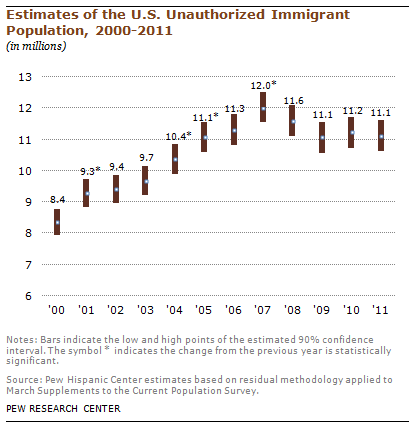Who are the 11 million?
With the recent push by Senate lawmakers and the White House for immigration reform, one number is being tossed around a lot. It has been estimated that there are about 11 million illegal residents in the United States. Where does that number come from and who exactly are these people?
Pew Hispanic Center demographer Jeffrey Passel answers these questions and helps to provide a clearer picture of illegal immigrant populations. The illegal immigrant population cannot be directly measured by any of the major national surveys. Unsurprisingly, response rates for voluntary, and even legally-required, surveys are particularly low for the illegal population. Instead, Passel and the Pew Hispanic Center rely on a methodology that indirectly measures this group of people. Here’s how it works:
Step 1) Estimate the total number of foreign-born residents using the Current Population Survey (CPS, a voluntary survey of households)
Step 2) Estimate the total number of legal immigrants by adding the following:
- People who arrived before 1980
- Refugees and Asylum approvals
- Green Card residents
- Other special, legal foreign-born populations
Step 3) Subtract the estimate from Step 2 from that of Step 1, then you have the illegal immigrant population.
The actual methodology is a little more complicated than this and involves statistical corrections to the CPS (which tends to underestimate the total number of foreign born) and demographic projections that assume age, sex, and country of birth-specific mortality and migration rates.
Despite the seemingly “Rube Goldberg” approach to arriving at an estimate of the total number of illegal immigrants, the estimates are considered to be fairly accurate and are close to independently derived estimates by the Department of Homeland Security (which uses a different methodology and different data sources).
But Passel and his fellow researchers at Pew go one step further and actually estimate the demographic characteristics of the illegal immigrant population. Here is a summary of their results:
1. The proportion of the illegal population living in family households is much greater than the native-born population.
2. Up to 60 percent of the illegal population comes from Mexico.
3. The illegal population has a much higher poverty rate (21%) than either the native-born (10%) or the legal immigrant population (13%).
4. The total number of illegal immigrants has declined slightly in recent years due to the recession and more stringent border patrol measures.



